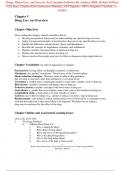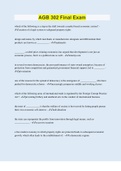1-1 Hebb, Gilbert , Hart & Ksir - Drugs, Behaviour and Society –Fourth Canadian Edition Instructor’s Manual © Copyright 20 23 McGraw -Hill Education . All Rights Reserved. Chapter 1 Drug Use: An Overview Chapter Objectives After reading this chapter, students should be able to: •Develop an analytical framework for understanding any specific drug -use issue.
•Apply four general principles of psychoactive drug use to any specific drug -use issue.
•Explain the differences among misuse, abuse, and dependence.
•Describe the concepts of dependence, tolerance, and withdrawal.
•Explain correlates and antecedents of adolescent drug use.
•Explain risk and protective factors for drug use.
•Discuss motives that people may have for illicit or dangerous drug -using behavior.
Chapter Vocabulary (in order of appearance in chapter) Psychoactive : having effects on thoughts, emotions, or behaviour. Marijuana : also spelled “marihuana.” Dried leaves of the Cannabis plant. Harm reduction strategies : Measures taken to address drug problems that are open to outcomes other than abstinence or cessation of use Correlates : a variable that is statistically related to some other variable, such as drug use. Risk factors : variables correlated with higher rates of drug use Protective factors : variables correlated with lower rates of drug use. Antecedents : a variable that occurs before some event, such as the initiation of drug use. Longitudinal study : a study done over time (months or years). Gateway : one of the fi rst drugs (e.g., alcohol or tobacco) used by a typical drug user. Reinforcement : a procedure in which a behavioural event is followed by a consequent event, such that the behaviour is then more likely to be repeated. The behaviour of taking a drug may be reinforced by the effect of the drug. Chapter Outline and Associated Learning Issues LO1, LO2, LO3, LO4 I. “The Drug Problem”
A. Talking About Drug Use
1. Who is taking the drug?
2. What drug is being taken?
3. When and where is the drug being taken?
4. Why is the drug being taken?
5. How is the drug being taken?
6. How much of the drug is being used?Drugs, Behaviour, and Society 4e (Canadian Edition) By Andrea Hebb, Robert Gilbert, Carl Hart, Charles Ksir (Instructor Manual, All Chapters, 100% Original Verified, A+ Grade) 1-2 Hebb, Gilbert , Hart & Ksir - Drugs, Behaviour and Society –Fourth Canadian Edition Instructor’s Manual © Copyright 20 23 McGraw -Hill Education . All Rights Reserved. B. Four Principles of Psychoactive Drugs 1. Drugs, per se, are not good or bad. a. How and why a drug is used is important. b. Drugs do not possess magical powers, to produce evil. c. Drugs are substances; behaviors and factors that lead to behaviors should also be a focus of concern. 2. Every drug has multiple effects. a. Psychoactive compounds that affect only one aspect of consciousnesses do not exist. b. Drugs that act on the brain may also produce effects on other parts of the body. 3. Both the size and the quality of a drug’s effect depend on the amount the individual has taken. a. An increased dose usually causes an increased effect. b. For some substa nces different doses cause different kind s of effects . 4. The effect of any psychoactive drug depends on the individual’s history and expectations. a. A person’s attitude can effect their perception of a drug experience . II. How Did We Get H ere? A. Have Things Really Changed? 1. Humans have used psychoactive drugs for thousands of years for therapeutic and recreational purposes. 2. Throughout history psy choactive drugs have played significant roles in society: treatment, religion, economics, law, government, language, and education. 3. Today many psychoactive drugs , those deemed to be too dangerous or too likely to produce dependence, are either restricted or tightly regulated through the Controlled Drug s and Substances Act. 4. Restriction and regulation of psychoactive drugs , both legal and illegal, has lead to enormous growth in illegal trade of such substances. 5. The costs associated with the regulation of illegal psychoactive drug trade are a significant burden to society. 6. Canada’s approach to reducing the harms associated with alcohol and othe r drugs is outlined in Canada’s Drug s and Substance s Strategy which uses a broad four -component approach includ ing: prevention, treatment, harm reduction, and enforcement. 7. Harm reduction strategies normalize drug –taking behaviour and focus on the avoidance of problems. 1-3 Hebb, Gilbert , Hart & Ksir - Drugs, Behaviour and Society –Fourth Canadian Edition Instructor’s Manual © Copyright 20 23 McGraw -Hill Education . All Rights Reserved. III. Drugs and Drug Use Today A. Extent of Drug Use 1. Current information on the prevalence and patterns of drug use comes from several sources, including survey s performed in: the general population, selected communities and, secondary and post-secondary institutions . Because of the limitations associated with such measurements accurate statistics are hard to attain. a. Self-reports may include a biased sample and be inaccurate or dishonest. B. Trends in Drug Use 1. The Canadian Alcohol and Drug Survey (CADS), previously called the Canadian Tobacco, Alcohol and Drug Survey (CTADS), follows nationwide trends in drug use among Canadians, 15 years of age and older, over time. Note that the CTADS replaced the prior CADUM. 2. Surveys like the Ontario Student Dru g Use Health Survey (OSDUHS), the Canadian Campus Survey (CCS) and, the American College Health Association – National College Health Assessment (ACHA -NCHA) measure trends in drug use among Canadian youth. 3. Surveys like the C ADS , ACHA -NCHA, CCS and , the OSDUHS have been created with four key objectives: a. To determine prevalence, incidence, and patterns of drug use. b. To measure personal and social harms associated with patterns of drug and alcohol use. c. To identify risk and protective factors related to drug and alcohol use and the consequences of such use in specific subgroups and the general Canadian population. d. To establish baseline data for use in the evaluation of treatment and prevention program effectiveness. 4. Drug use patterns seen across multiple surveys are mo re likely to be accurate. 5. Survey data have shown that p atterns a nd rates of drug and alcohol use change with time. a. The perceived availability of alcohol and other drugs does not appear to affect rates of use. b. Correlations may exist between the perception of risk and the reported use of alcohol and other drugs. 6. Decreases or increases in drug use are not related to changes in government legislation, but are related changes in a broad range of attitudes and behaviours among Canadians – what we can refer to as social trends . LO5, LO6, LO7 IV. Correlates of Drug Use A. What Factors Are Considered? 1-4 Hebb, Gilbert , Hart & Ksir - Drugs, Behaviour and Society –Fourth Canadian Edition Instructor’s Manual © Copyright 20 23 McGraw -Hill Education . All Rights Reserved. 1. Surveyors look for common characteri stics in those who use drugs, in compar ison with those who do not use drugs. 2. Study limitations can make it difficult to determine the effects of some factors. B. Risk and Protective Factors 1. Risk factors are correlated with higher rates of drug use. 2. Risk factors for drug use include having friends who use drugs, engaging in fighting or stealing, perceiving that substance use is prevalent at school, knowing adults who use drugs, and having a positive attitude towards drugs. 3. The kids most likely to use marijuana frequently live in a rough neighborhood, have little parental monitoring, steal and get into fights, may not be involved in religious activities, and do poorly in school. 4. Protective factors are correlated with lower rates of drug use. 5. Protective factors for drug use include perceiving strong sanctions against drug use at school, having supportive parents, being committed to school, being involved in religious activities, and participating in two or more extracurricular activities. 6. Overall, studies of risk and protective factors suggest that adolescents who are more likely to smoke cigarettes, drink heavily, and smoke marijuana are also more likely to engage in other deviant behaviors, such as stealing, fighting, and early sexual behaviors. C. Gender 1. Males are more likely to use alcohol and tobacco, smoke marijuana, and use other illicit drugs than are females. D. Level of Education 1. Those with more education (post -secondary degrees, compared with those who completed high school only) are much more likely to drink alcohol and somewhat less likely to us e marijuana or other illicit drugs . E. Personality Variables 1. Evidence for correlations between traditional personality traits and drug use is somewhat weak and inconsistent. 2. Several studies focus on “impulsivity” as correlating with rates of substance use. 3. Personality factors may play a role in whether someone decides to try alcohol , heroin or marijuana, but they may play a large role in whether drug use develops into a serious problem. F. Genetics 1. Genetic studies are beginning to show clear association between genetic variances (alleles) and substance -related disorders. H. Antecedents of Drug U se 1. Antecedents such as aggressive behavior in children are characteristics that predict later initiation of drug use. 2. Antecedents can be researched through longitudinal studies that track individuals over time. 3. Gateway substances are the drugs first used by a typical drug user.





